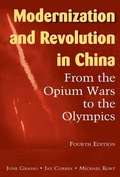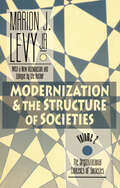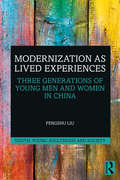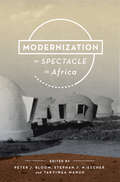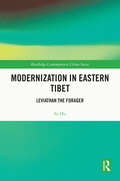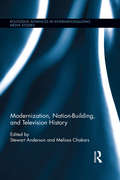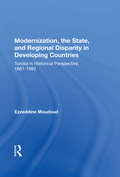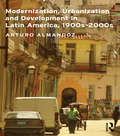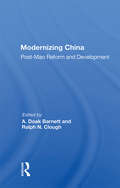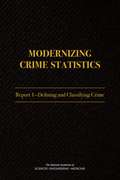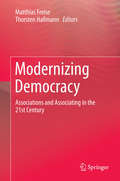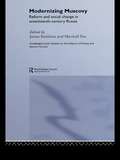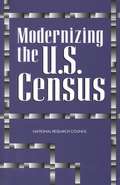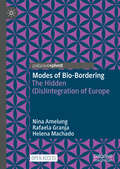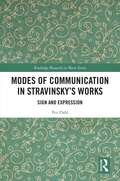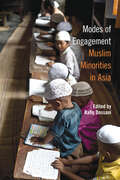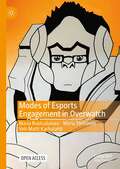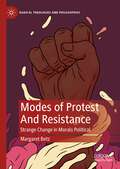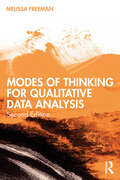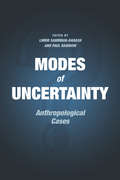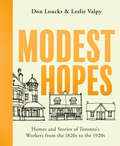- Table View
- List View
Modernization and Revolution in China: From the Opium Wars to the Olympics
by June M Grasso Michael G. Kort Jay P CorrinExtensively revised and updated, this popular text conveys the drama of China's struggle to modernize against the backdrop of a proud and difficult history. Spanning the years from China's humiliating defeat in the Opium Wars to its triumphant hosting of the 2008 summer Olympics, the authors narrate the major developments of that journey: the breakdown of imperial China in the face of Japanese and Western encroachments; Sun-Yatsen and the founding of the Chinese republic; the early struggles between the ideologies and armies of Chiang Kai-shek and Mao Zedong; China's bitter and costly war with Japan; the final shootout that sent Chiang to Taiwan and Mao to Beijing; the turbulent first decades of the People's Republic; and the dramatic shift to a globalizing economic strategy. This edition features all new analysis of issues facing China's leaders today, including environmental challenges, rural economic developments, corruption, the current economic climate, China's relations with its neighbors and the United States, the latest Tibet crisis, and the reelection of Hu Jintao. The authors have also incorporated some of the latest scholarship on Chinese historical events, making this the best and most up-to-date brief text on modern China currently available.
Modernization and the Structure of Societies: The Organisational Contexts of Societies
by Marion J. Levy Jr.In Modernization and the Structure of Societies, Marion Levy shows the interdependencies of societies as a systematic whole in matters that are relevant for international affairs. He distinguishes different types of societies while simultaneously showing elements common to all societies. In a new epilogue being added to this edition, titled "Modernization Exhumed," the author alleges that criticism of modernization theory has generally been ideological or otherwise nonscientific. He provides a strong defense of his hypothesis. In his new introduction, he concentrates on the concept of interdependency. Modernization and the Structure of Societies is crucial to the understanding of contemporary international problems. It is a necessary addition to the personal libraries of sociologists, political scientists, and scholars of international affairs., Levy writes so as to produce strong reactions, but this does not obscure his real contribution. Because of his ambitious effort to synthesize a tremendous amount of available scholarship, the study is certain to last for a long time as a standard reference in the field of comparative sociology."—Morris Janowitz, American Journal of Sociology, "A giant book raising innumerable problems, often an exasperating book, yet important and likely to be much referred to by writers on comparative politics and administration."—Fred W. Riggs, American Political Science Review.
Modernization as Lived Experiences: Three Generations of Young Men and Women in China (Youth, Young Adulthood and Society)
by Fengshu LiuThis book examines, in a culturally and contextually sensitive way, the particularity of what it means to be young in post-Mao China undergoing rapid and dramatic transformation by comparing childhood and youth experiences over three generations. The analysis draws on life-history interviews with Beijing young men and women in their last upper secondary year, their parents and their grandparents. The book offers a comprehensive coverage of the various aspects of life pertinent to youth experiences and compares each of these across three generations, treating them as interrelated and mutually affecting processes – childhood, intergenerational relationships, education and future plans, gender and sexuality. By offering both men’s and women’s accounts of their childhood and youth experiences, which for the three generations combined extend over nearly a century, the book sheds useful light on how gender and sexuality have evolved in China. Fengshu Liu concludes that the young generation’s lives feature a ‘maximization desire’, in sharp contrast to the two older generations’ childhood and youth experiences. The book meticulously weaves rich ethnographic details and individual life stories into a larger and unfolding picture of historical, social and cultural trends, while providing critical insight into Chinese modernization and modernity against the backdrop of globalization. It can thus be an enjoyable read also for people beyond the academia interested in China’s social and cultural transformation and its children and youth.
Modernization as Spectacle in Africa
by Peter J. Bloom Takyiwaa Manuh Stephan F. MiescherFor postcolonial Africa, modernization was seen as a necessary outcome of the struggle for independence and as crucial to the success of its newly established states. Since then, the rhetoric of modernization has pervaded policy, culture, and development, lending a kind of political theatricality to nationalist framings of modernization and Africans' perceptions of their place in the global economy. These 15 essays address governance, production, and social life; the role of media; and the discourse surrounding large-scale development projects, revealing modernization's deep effects on the expressive culture of Africa.
Modernization in Eastern Tibet: Leviathan the Forager (ISSN)
by Su HuUsing ethnographic materials and documents from East Tibetan villages, this book addresses the impact of modernization on everyday life and the ways in which it melds with traditional forms of knowledge to create a new Tibetan identity and scientific rationality.Including cases centred on meteorology, geography, and seismology, the book assesses a wide range of traditional local activities, including foraging, farming, and domestic practices, and argues that and demonstrates how science, technology, and ideas about modernity have all influenced these activities. It highlights that when inconsistencies among different knowledges emerge, modernization can create inconsistent assemblages of modern and traditional practices and reveal the multiplicity of everyday life.Using these examples of everyday life to portray the complexity of day-to-day existence in Tibet, this book will be of huge interest to students and scholars of Tibet, China, human geography, anthropology, and the sociology of science and technology.
Modernization, Nation-Building, and Television History (Routledge Advances in Internationalizing Media Studies)
by Stewart Anderson Melissa ChakarsThis innovative collection investigates the ways in which television programs around the world have highlighted modernization and encouraged nation-building. It is an attempt to catalogue and better understand the contours of this phenomenon, which took place as television developed and expanded in different parts of the world between the 1950s and the 1990s. From popular science and adult education shows to news magazines and television plays, few themes so thoroughly penetrated the small screen for so many years as modernization, with television producers and state authorities using television programs to bolster modernization efforts. Contributors analyze the hallmarks of these media efforts: nation-building, consumerism and consumer culture, the education and integration of citizens, and the glorification of the nation’s technological achievements.
Modernization, The State, And Regional Disparity In Developing Countries: Tunisia In Historical Perspective, 1881-1982
by Ezzeddine MoudoudThis book provides a historical context for understanding why regional disparities emerged in Tunisia and why reducing those disparities has been so difficult. It implies that the failure of regional development in Tunisia does not lie in regional planning, which had never been seriously tried.
Modernization, Urbanization and Development in Latin America, 1900s - 2000s (Planning, History and Environment Series)
by Arturo AlmandozIn this book Arturo Almandoz places the major episodes of Latin America’s twentieth and early twenty-first century urban history within the changing relationship between industrialization and urbanization, modernization and development. This relationship began in the early twentieth century, when industrialization and urbanization became significant in the region, and ends at the beginning of the twenty-first century, when new tensions between liberal globalization and populist nationalism challenge development in the subcontinent, much of which is still poverty stricken. Latin America’s twentieth-century modernization and development are closely related to nineteenth-century ideals of progress and civilization, and for this reason Almandoz opens with a brief review of that legacy for the different countries that are the focus of his book – Mexico, Chile, Brazil, Argentina and Venezuela – but with references to others. He then explores the regional distortions, which resulted from the interaction between industrialization and urbanization, and how the imbalance between urbanization and the productive system helps to explain why ‘take-off’ was not followed by the ‘drive to maturity’ in Latin American countries. He suggests that the close yet troublesome relationship with the United States, the recurrence of dictatorships and autocratic regimes, and Marxist influences in many domains, are all factors that explain Latin America’s stagnation and underdevelopment up to the so-called ‘lost decade’ of 1980s. He shows how Latin America’s fate changed in the late twentieth and early twenty-first century, when neoliberal programmes, political compromise and constitutional reform dismantled the traditional model of the corporate state and centralized planning. He reveals how economic growth and social improvements have been attained by politically left-wing yet economically open-market countries while others have resumed populism and state intervention. All these trends make up the complex scenario for the new century – especially when considered against the background of vibrant metropolises that are the main actors in the book.
Modernizing China: Post-Mao Reform And Development
by A. Doak Barnett Ralph N. CloughSince the death of Mao, China has entered a new period in its development. Turning away from the all-encompassing emphasis on revolutionary struggle and ideological transformation that characterized the last years of the Maoist era, China's leaders under Deng Xiaoping have initiated dramatic new reform and development policies. In original essays, the contributors, all senior specialists on contemporary China, analyze the reasons for the new policies, the nature and impact of the changes now occurring, and the prospects for a continuation of these policies in the future. Specifically, they examine the Chinese polity as a "consultative authoritarian" system, the farreaching changes in China's agriculture, important shifts in foreign economic relations, the gradual modernization policy pursued by its military leaders, the relaxation of controls on cultural life, and the possibility that current social policies may well increase equality rather than inequality in Chinese society. The authors conclude that it is too early to judge the eventual, long-term outcome of current reforms, which they believe grew out of the political crises and chronic economic problems that afflicted China in the late 1960s and early 1970s. Although they see some opposition and built-in limits to reform, on balance they foresee strong support for continued reform and believe it will be difficult for future leaders to reverse course.
Modernizing Crime Statistics: Defining and Classifying Crime
by Engineering Medicine National Academies of SciencesTo derive statistics about crime – to estimate its levels and trends, assess its costs to and impacts on society, and inform law enforcement approaches to prevent it – a conceptual framework for defining and thinking about crime is virtually a prerequisite. Developing and maintaining such a framework is no easy task, because the mechanics of crime are ever evolving and shifting: tied to shifts and development in technology, society, and legislation. Interest in understanding crime surged in the 1920s, which proved to be a pivotal decade for the collection of nationwide crime statistics. Now established as a permanent agency, the Census Bureau commissioned the drafting of a manual for preparing crime statistics—intended for use by the police, corrections departments, and courts alike. The new manual sought to solve a perennial problem by suggesting a standard taxonomy of crime. Shortly after the Census Bureau issued its manual, the International Association of Chiefs of Police in convention adopted a resolution to create a Committee on Uniform Crime Records —to begin the process of describing what a national system of data on crimes known to the police might look like. The key distinction between the rigorous classification proposed in this report and the “classifications” that have come before in U.S. crime statistics is that it is intended to partition the entirety of behaviors that could be considered criminal offenses into mutually exclusive categories. Modernizing Crime Statistics: Report 1: Defining and Classifying Crime assesses and makes recommendations for the development of a modern set of crime measures in the United States and the best means for obtaining them. This first report develops a new classification of crime by weighing various perspectives on how crime should be defined and organized with the needs and demands of the full array of crime data users and stakeholders.
Modernizing Democracy
by Matthias Freise Thorsten HallmannModernizing Democracy brings together scholars focusing the role of associations and associating in contemporary societies. Organizations and associations have been identified as the "meso level of society" and as the "basic elements of democracy". They are important providers of welfare services and play an important role between the individual and political spheres. In recent years the environment of associations and associating has changed dramatically. Individualization, commercialization and globalization are challenging both democracy and the capability of associations to fulfill the functions attributed to them by social sciences. This change provides the central question of the volume: Is being part of an organization or association becoming an outdated model? And do associations still have the capacity of modernizing societies or are they just outdated remnants of post-democracy? The contributions to Modernizing Democracy will be organized into: Studying Association and Associating in the 21st Century, Associating in Times of Post-Democracy and Associations and the Challenge of Capitalist Development. The book will be attractive to third sector researchers as well as a broader academic community of political scientists, sociologists, economists, legal scientists and related disciplines.
Modernizing Muscovy: Reform and Social Change in Seventeenth-Century Russia (Routledge Studies in the History of Russia and Eastern Europe)
by Jarmo Kotilaine Marshall PoeFirst Published in 2004. Routledge is an imprint of Taylor & Francis, an informa company.
Modernizing Tradition: Gender and Consumerism in Interwar France and Germany
by Adam C. StanleyIn the turbulent decades after World War I, both France and Germany sought to return to an idealized, prewar past. Many people believed they could recapture a sense of order and stability by reinstituting traditional gender roles, which the war had thrown off balance. While French and German women necessarily filled men's roles in factories and other jobs during the war, those who continued to lead active working lives after World War I risked being called "modern women." Far from a compliment, this derogatory label encompassed everything society found threatening about women's new place in public life: smoking, working women who preferred independence and sexual freedom to a traditional role in the home. Society felt threatened by the image of the "modern woman," yet also realized that conceptions of femininity needed to accommodate the cultural changes brought about by the Great War.In Modernizing Tradition, Adam C. Stanley explores how interwar French and German popular culture used commercial images to redefine femininity in a way that granted women some access to modern life without encouraging the assertion of female independence. Examining advertisements, articles, and cartoons, as well as department store publicity materials from the popular press of each nation, Stanley reveals how the media attempted to convince women that--with the help of newly available consumer goods such as washing machines, refrigerators, and vacuum cleaners--being a mother or a housewife could be empowering, even liberating. A life devoted to the home, these images promised, need not be an unmitigated return to old-fashioned tradition but could offer a rewarding lifestyle based on the wonders and benefits of modern technology. Stanley shows that the media carefully limited women's association with modernity to those activities that reinforced women's traditional roles or highlighted their continued dependence on masculine guidance, expertise, and authority.In this cross-national study, Stanley brings into sharp relief issues of gender and consumerism and reveals that, despite the larger political differences between France and Germany, gender ideals in the two countries remained virtually identical between the world wars. That these concepts of gender stayed static over the course of two decades--years when nearly every other aspect of society and culture seemed to be in constant flux--attests to their extraordinary power as a force in French and German society.
Modernizing the U.S. Census
by Charles Schultze Barry EdmondstonThe U.S. census, conducted every 10 years since 1790, faces dramatic new challenges as the country begins its third century. Critics of the 1990 census cited problems of increasingly high costs, continued racial differences in counting the population, and declining public confidence. <P><P>This volume provides a major review of the traditional U.S. census. Starting from the most basic questions of how data are used and whether they are needed, the volume examines the data that future censuses should provide. It evaluates several radical proposals that have been made for changing the census, as well as other proposals for redesigning the year 2000 census. <P><P>The book also considers in detail the much-criticized long form, the role of race and ethnic data, and the need for and ways to obtain small-area data between censuses.
Modes of Bio-Bordering: The Hidden (Dis)integration of Europe
by Helena Machado Rafaela Granja Nina AmelungThis open access book explores how biometric data is increasingly flowing across borders in order to limit, control and contain the mobility of selected people, namely criminalized populations. It introduces the concept of bio-bordering, using it to capture reverse patterns of bordering and ordering practices linked to transnational biometric data exchange regimes. The concept is useful to reconstruct how the territorial foundations of national state autonomy are partially reclaimed and, at the same time, partially purposefully suspended. The book focuses on the Prüm system, which facilitates the mandatory exchange of forensic DNA data amongst EU Member States. The Prüm system is an underexplored phenomenon, representing diverse instances of bio-bordering and providing a complex picture of the hidden (dis)integration of Europe. Particular legal, scientific, technical and political dimensions related to the governance and uses of biometric technologies in Germany, the Netherlands, Poland, Portugal and the United Kingdom are specifically explored to demonstrate both similar and distinct patterns.
Modes of Communication in Stravinsky’s Works: Sign and Expression (Routledge Research in Music)
by Per DahlIgor Stravinsky left behind a complex heritage of music and ideas. There are many examples of discrepancies between his literate statements about music and musicians and his musical compositions and activity. Per Dahl presents a model of communication that unveils a clear and logical understanding of Stravinsky's heritage, based on the extant material available. From this, Dahl argues the case for Stravinsky’s music and his ideas as separate entities, representing different modes of communication. As well as describing a triangular model of communication, based on a tilted and extended version of Ogden's triangle, Dahl presents an empirical investigation of Stravinsky's vocabulary of signs and expressions in his published scores - his communicative mode towards musicians. In addition to simple statistics, Dahl compares the notation practice in the composer’s different stylistic epochs as well as his writing for different sizes of ensembles. Dahl also considers Stravinsky’s performances and recordings as modes of communication to investigate whether the multi-layered model can soften the discrepancies between Stravinsky the literate and Stravinsky the musician.
Modes of Engagement: Muslim Minorities in Asia
by Rafiq DossaniOf Asia's 800 million Muslims, 215 million are minorities within their countries. These Muslim minorities have experienced a persistent decline in their socioeconomic and political status. Along with this decline, they are increasingly identified by their faith and largely accorded no other identity for civic relations. Why have these Muslim minorities been particularly affected during a time of unprecedented opportunities for the mainstream in Asia's unprecedented era of growth and rising freedoms? Using detailed analyses of China, India, and the Philippines, Modes of Engagement argues that key factors in this phenomenon include the linkage between socioeconomic decline, loss of political power, and narrowing of identity; nationalism and its associated connotations of the assimilation of minorities; the weakness of civil society generally in Asia; and the rise in regional and global alliances for security and trade. Contributors include Wajahat Habibullah (National Commission for Minorities and National Institute of Technology, India), Rakesh Basant (Indian Institute of Management), Dru C. Gladney (Pomona College), and Joseph Chinyong Liow (Nanyang Technological University's S. Rajaratnam School of International Studies, Singapore).
Modes of Esports Engagement in Overwatch
by Veli-Matti Karhulahti Maria Ruotsalainen Maria TörhönenThis Open Access book provides a comprehensive review of the rapidly developing esport phenomenon by examining one of its contemporary flagship titles, Overwatch (Blizzard Entertainment 2016), through three central themes and from a rich variety of research methods and perspectives. As a game with more than 40 million individual players, an annual international World Cup, and a franchised professional league with teams from Canada, China, Europe, South Korea, and the US, Overwatch provides a multifaceted perspective to the cultural, social, and economic topics associated with the development of esports, which has begun to attract attention from both commercial and academic audiences.The book starts with an introduction chapter to Overwatch and esports engagement in general, co-authored by the editors. This is followed by 15 unique chapters from scholars within the field of game cultures and esports, representing ten different nationalities. The contributions construct thematic sections that divide the book into three parts: Players, Diverse Audiences? and Fan & Fiction Work. As such, the parts provide a wide-ranging overview of esport engagement, thus disclosing the phenomenon’s cross-cultural, transmedial, and interconnected relations that have not been probed earlier in a single anthology.
Modes of Protest And Resistance: Strange Change in Morals Political (Radical Theologies and Philosophies)
by Margaret BetzThis book presents a philosophical analysis of the different forms of political resistance and protest. It explores the normative space of resistance that is beyond self-defense and civil disobedience, and proposes the concept of “resistance violence” as a separate and special normative category. Instances that fall under this category can be, accordingly justified, even if they prove to be practically ineffective, by appealing to their role in preserving or upholding the dignity of the resistors or those who they aim to protect. Margaret Betz draws from important and interesting historical examples to establish the concept, and proposes to apply it to better understand contemporary struggles against injustice.
Modes of Thinking for Qualitative Data Analysis
by Melissa FreemanModes of Thinking for Qualitative Data Analysis offers a creative and comparative account of the conceptual and philosophical underpinnings of six prominent analytical movements used by interdisciplinary qualitative researchers: Categorical thinking, narrative thinking, dialectical thinking, poetic thinking, diffractive thinking, and decolonial thinking.Each “mode of thinking” engages in a particular process for analytical sense-making. Every chapter describes core characteristics of the focal analytical movement along with examples to illustrate what that approach might look like in practice. By presenting these analytical movements in the space of a single text, the author not only highlights their unique contributions to qualitative analysis but also creates a structure from which to understand their strengths and challenges, as well as the kind of outcomes and realities each participates in shaping.This book is a thought-provoking resource for experienced and novice interdisciplinary qualitative researchers seeking to deepen their understanding of the variety of ways qualitative analysis is, and could be, theorized and practiced.
Modes of Uncertainty: Anthropological Cases
by Paul Rabinow Limor Samimian-Darah and Paul RabinowModes of Uncertainty offers groundbreaking ways of thinking about danger, risk, and uncertainty from an analytical and anthropological perspective. Our world, the contributors show, is increasingly populated by forms, practices, and events whose uncertainty cannot be reduced to risk—and thus it is vital to distinguish between the two. Drawing the lines between them, they argue that the study of uncertainty should not focus solely on the appearance of new risks and dangers—which no doubt abound—but also on how uncertainty itself should be defined, and what the implications might be for policy and government. Organizing contributions from various anthropological subfields—including economics, business, security, humanitarianism, health, and environment—Limor Samimian-Darash and Paul Rabinow offer new tools with which to consider uncertainty, its management, and the differing modes of subjectivity appropriate to it. Taking up policies and experiences as objects of research and analysis, the essays here seek a rigorous inquiry into a sound conceptualization of uncertainty in order to better confront contemporary problems. Ultimately, they open the way for a participatory anthropology that asks crucial questions about our contemporary state.
Modes of the Tragic in Spanish Cinema
by Luis M. GonzálezThis book focuses on expressions of the tragic in Spanish cinema. Its main premise is that elements from the classical and modern tragic tradition persist and permeate many of the cultural works created in Spain, especially the films on which the book centers this study. The inscrutability and indolence of the gods, the mutability of fortune, the recurrent narratives of fall and redemption, the unavoidable clash between ethical forces, the tension between free will and fate, the violent resolution of both internal and external conflicts, and the overwhelming feelings of guilt that haunt the tragic heroine/hero are consistent aspects that traverse Spanish cinema as a response to universal queries about human suffering and death.
Modest Hopes: Homes and Stories of Toronto's Workers from the 1820s to the 1920s
by Don Loucks Leslie ValpyCelebrating Toronto’s built heritage of row houses, semis, and cottages and the people who lived in them.Despite their value as urban property, Toronto’s workers’ cottages are often characterized as being small, cramped, poorly built, and in need of modernization or even demolition. But for the workers and their families who originally lived in them from the 1820s to the 1920s, these houses were far from modest. Many had been driven off their ancestral farms or had left the crowded conditions of tenements in their home cities abroad. Once in Toronto, many lived in unsanitary conditions in makeshift shantytowns or cramped shared houses in downtown neighbourhoods such as The Ward. To then move to a self-contained cottage or rowhouse was the result of an unimaginably strong hope for the future and a commitment to family life. Through the stories of eight families who lived in these “Modest Hopes,” authors Don Loucks and Leslie Valpy bring an important but forgotten part of the Toronto narrative to life. They illuminate the development of Toronto’s working-class neighbourhoods, such as Leslieville, Corktown, and others, and explain the designs and architectural antecedents of these undervalued heritage properties.
Modest_Witness@Second_Millennium. FemaleMan_Meets_OncoMouse: Feminism and Technoscience
by Donna J. Haraway Thyrza GoodeveOne of the founders of the posthumanities, Donna J. Haraway is professor in the History of Consciousness program at the University of California, Santa Cruz. Author of many books and widely read essays, including the now-classic essay "The Cyborg Manifesto," she received the J.D. Bernal Prize in 2000, a lifetime achievement award from the Society for Social Studies in Science. Thyrza Nicholas Goodeve is a professor of Art History at the School of Visual Arts.
Modi's India: Hindu Nationalism and the Rise of Ethnic Democracy
by Christophe JaffrelotA riveting account of how a popularly elected leader has steered the world's largest democracy toward authoritarianism and intoleranceOver the past two decades, thanks to Narendra Modi, Hindu nationalism has been coupled with a form of national-populism that has ensured its success at the polls, first in Gujarat and then in India at large. Modi managed to seduce a substantial number of citizens by promising them development and polarizing the electorate along ethno-religious lines. Both facets of this national-populism found expression in a highly personalized political style as Modi related directly to the voters through all kinds of channels of communication in order to saturate the public space.Drawing on original interviews conducted across India, Christophe Jaffrelot shows how Modi's government has moved India toward a new form of democracy, an ethnic democracy that equates the majoritarian community with the nation and relegates Muslims and Christians to second-class citizens who are harassed by vigilante groups. He discusses how the promotion of Hindu nationalism has resulted in attacks against secularists, intellectuals, universities, and NGOs. Jaffrelot explains how the political system of India has acquired authoritarian features for other reasons, too. Eager to govern not only in New Delhi, but also in the states, the government has centralized power at the expense of federalism and undermined institutions that were part of the checks and balances, including India's Supreme Court.Modi's India is a sobering account of how a once-vibrant democracy can go wrong when a government backed by popular consent suppresses dissent while growing increasingly intolerant of ethnic and religious minorities.
